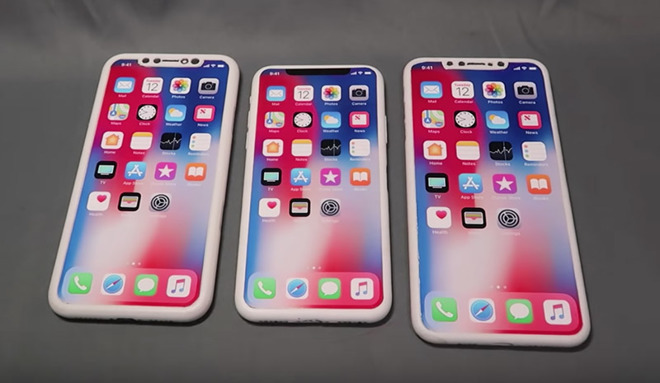The reported addition of the Japan-based Nichia as an exclusive supplier to Apple has seemingly revealed how the LCD model in this fall's iPhone refresh will have a similar edge-to-edge display as the two OLED models, also expected to launch this year.
Nichia is a producer of LED chips used for backlighting in LCD panels, and will be supplying the component to Apple for the 2018 iPhone, industry sources advised to DigiTimes. The specific component ordered by Apple is a 0.3t LED chip that may solve the production problem of creating an LCD-based edge-to-edge display.
Smartphones with LCD screens typically use 0.4t LED chips for the backlighting, which results in a bottom bezel measuring between 4 and 4.5 millimeters in size. Using 0.3t LED chips, this space can be reduced down to between 2 and 2.5 millimeters, a much more acceptable size for the intended application in upcoming iPhones.
OLED, like the version used in the iPhone X, does not require a backlight as the individual pixels can produce their own light. This also allows for OLED to be produced for flexible or folding displays, making it extremely useful for producing edge-to-edge screens.
The sources advised that, due to the increased difficulty in packaging the smaller chips, Nichia began trial production in the first half of 2018, supplying the component to Chinese and Japanese smartphone producers for use in premium devices.
Trial production for Apple's new wave of iPhones is expected to start this month, with small-volume production taking place in August, then volume manufacturing in September. Taking into account the timing, the report sources advised Nichia's production capacity for the chips will be almost saturated for the second half of 2018, manufacturing just for the iPhone.
It is currently anticipated Apple has three iPhones for launch this fall, with the 6.1-inch LCD model expected to be the lower-cost version alongside a refreshed and higher-specification iPhone X and a 6.5-inch OLED "iPhone X Plus." A recent set of benchmarks suggests the A12 processor that will be introduced in the new models will have six cores and a base clock speed of 2.49GHz, and may be accompanied by up to 4 gigabytes of RAM.
 Malcolm Owen
Malcolm Owen







-m.jpg)






 Charles Martin
Charles Martin
 Christine McKee
Christine McKee
 Wesley Hilliard
Wesley Hilliard

 Andrew Orr
Andrew Orr
 William Gallagher
William Gallagher
 Sponsored Content
Sponsored Content







5 Comments
I don't think I'll ever get used to a pentile display.
With the Plus phones getting so tall and with great pixel density I wonder whether a split screen display option would be useful on the iPhone? It might be rather nice to have Messages (or any other app) running in one pane and Safari (or any other app) running in the other, or possibly two Messages panes running simultaneously. The toolbar could autohide like it does on the current iPad so each pane remains as large as possible. Optionally allowing for scaling or having the app adapt its content within the pane size also would be interesting. One challenge is how to handle the popup onscreen keyboard. My suggestion would be to always put the keyboard in the bottom pane, so if the bottom pane has focus when the keyboard is invoked you'd temporarily move the bottom pane to the top pane while typing and then restore both panes when the keyboard is closed. This may be totally impractical be it may be worth prototyping ways to make better use of all that additional screen real estate in these mega-iPhones. Again, it would be optional.
Apple, please, introduce a “iPhone $&@%”, no matter how you name it,
I want it in 5s size but with X’s style edge to edge screen, LCD or OLED or what iPhone standard quality screen is good enough, with A11 cpu (for longer product life), and I don’t really need face ID or a new fancy camera.
If the price of this is not higher than iPhone X, take my money, since I may use it for three or four years or even more, the price is relatively fair, and just need a single hand to use my iPhone will make my life more easier.
Nichia is a well known manufacturer of LED’s and other products of this type. I have confidence in their products.
by the way, the “fake” iPhones in the top picture are the first ones I’ve seen that don’t make the mistake of making the notch wider and deeper for the larger phones. For some reason, the people who have been drawing mock-ups seem to forget that the notch will be the same size no matter the size of the screen, and will therefore take up less space in a larger screen. They just size up the phones to make them larger. That’s wrong.